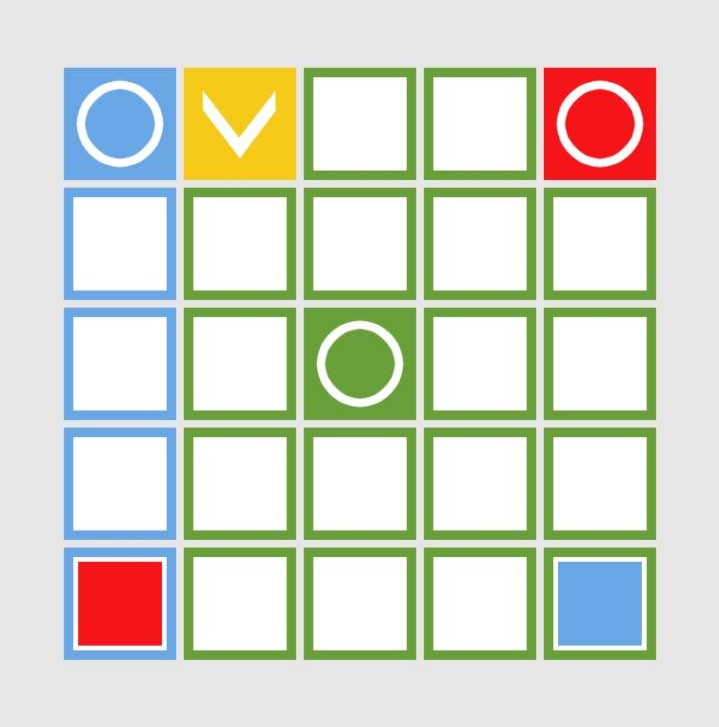Puzzle Design
 |
|---|
Basic Puzzle Characteristics
A puzzle is very broadly defined as a non-combat event or series of events that requires the player to complete a task or an action or some series of tasks or actions in order to progress play.
Necessary Traits of Puzzle Design
-
Affordances: It should be easy to figure out the rules and controls.
-
Identifiable patterns: Patterns should be clear so that players are able to identify a series of possibilities.
-
Ease of use: Good user interface (UI).
-
Reward player skill: The player should be able to improve his or her skill if is encountering the puzzle many times.
Additional traits to cause the puzzle to be more interesting
-
Immersion: Smooth transition between the main game and mini-game
-
Meaningful consequences: in the game, outside of the mini-game: Not just “you unlock a door” but “you get cool items.”
What Makes Puzzles Fun?
The inclusion of puzzles should only be done to support the core of the main game.
-
Puzzles are a direct obstacle to reaching a goal.
-
The fun in a puzzle generally comes from the thrill of victory, the sense of achievement of solving a difficult puzzle, and the gradual sense of mastery that precedes those moments.
Puzzle Types
Riddles
There are two sisters: one gives birth to the other and she, in turn, gives birth to the first. Who are the two sisters?
- Are questions that have one right, not obvious, answer.
- Involves a play on words that requires a non-standard interpretation in order to solve it.
- Require time and effort to create, yet is only encountered by a player once.
- Aren’t particularly fun to try to solve for the majority of players.
- Some techniques to make riddles less frustrating are:
- Make riddles optional. For example, giving useful but non-essential items.
- Offer clues. For example, how many letters are in the answer, or getting hints by talking to NPCs.
- Allow alternate solutions. By giving the option to complete a different challenge.
Lateral Thinking

Place a pencil on this sheet of paper. Without removing the pencil from the page, draw four straight lines in such a way that all nine dots are connected. (solution)
-
Pose tricky questions that have a single correct answer.
-
Lead players make assumptions that are not true.
-
Solving requires the player to question his or her assumptions.
-
Like riddles, lateral-thinking puzzles:
- Are expensive to create; can only be experienced once and cause frustration from blocking the game.
- Are addressed by the same game design solutions.
Spatial Reasoning
| Final State | State “Just before last” |
|---|---|
 |  |
| Flowit! at f-droid | Flowit! at play store |
- Involve the manipulation of objects, either in the mind or on the playing surface.
Pattern Recognition
- Require the player to look for and identify a pattern when presented with information.
Logic
- You have four orbs, coloured black, blue, red and yellow.
- You must place them on four pedestals in the correct order.
- Black is on the left.
- Red is next to blue.
- Yellow is to the right of red.
- Require the player to take a set of given information and derive additional information to find the solution.
Exploration
- For many players, exploration is fun in and of itself.
- Locating a specific person in a large town,
- finding a path through a maze-like series of corridors,
- or finding all of the treasure chests on the current level.
It can also become an obstacle when players encounter an area they cannot enter or cross.
Item Use
- The player must figure out which item(s) to use, in what order, to solve a particular challenge.
- Are more challenging if items can be combined or used on each other, or if they are used in non-obvious ways.
- Clues can be given about non-obvious item use.
All for One and One for All
Once it’s determined that a puzzle is too easy or too difficult to solve, there are a few things the designer can do to balance things accordingly
Add or remove additional clues.
Giving successive hints makes puzzles easier to solve.
Move the clues around.
If clues are located right next to the puzzle, players can see the connection easily. If they are found far in the map, the player may not immediately make the connection, which increases the difficulty.
Allow multiple solutions.
If many of your testers are trying a particular invalid solution, you can either change the puzzle to make that solution correct, or provide additional clues to make it clear that the invalid solution will not work.
Offer dynamic, play-sensitive help.
Some games offer the player additional help after he has failed at a task the first time.
Make use of dynamic difficulty adjustment (DDA).
The game makes itself easier or harder based on how the player is doing in order to preserve a proper level of challenge.
Remove linearity.
If players are prevented from going in a particular direction they should have another direction to go or other options — replace a single goal with multiple ones.
Add a time limit.
A relatively simple puzzle becomes more challenging when the player is under time pressure.
Add or remove feedback.
With no feedback, the player must continue trying with no additional information. But if some indication of why their solution did not work is given, they can adjust their approach.
Test the game on a variety of players.
Some game designers make the mistake of using skilled players as their only gauge of difficulty. Nothing reveals potential stuck points like a fresh battery of testers introduced to the game on a regular basis.